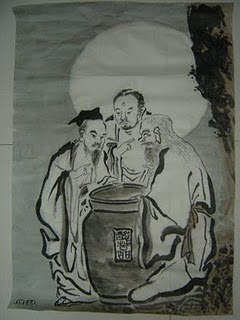As the legend goes, Kombucha was invented in the Qin Dynasty (221 BC) for the Emperor, Qin Shi Huangdi. The Chinese are famed for their quest for all manner of longevity elixirs. From Kombucha to ginseng to snake’s blood, they have always looked to nature to cure what ails them.
BONUS FACT: This is the origin story for World Kombucha Day invented by Alex Kombucha to commemorate our love and respect for Kombucha across the globe – celebrate every year on 2.21 – Feb 21st
From there it spread throughout Asia. Purportedly in 414 AD, a Korean Dr. Kombu brought this famous tonic to the Emperor Ingyō of Japan. Chá (茶) is the Chinese word for tea.
Kombu+cha = Kombucha.
Ancient Japanese warriors are said to have carried the tonic into battle, fermenting as they moved. Others write that a fermented, vinegary beverage filled the travel flasks of Genghis Khan and his armies.1

In China, traditionally the grandmother cared for and cultivated the Kombucha using the ancient tradition of Continuous Brewing, passed down from mother to daughter. During the Cultural Revolution, every household had a pot of Kombucha brewing, and though it had once fallen out of the daily routine of the modern Chinese lifestyle, it is making a comeback.
From Ancient China, Kombucha traveled via the Silk Road to Russia, where it was called tea kvass or čajnyj grib [чайный гриб] which means “mushroom tea.” It consequently spread to all of Europe where it was very popular until World War II, when rationing made sugar and tea hard find. It is still quite popular in Germany where it is known as teepilz, “tea fungus.”
There is even a reference to Ruth’s “vinegary beverage” in the Old Testament. It almost certainly was Kombucha or something very much like it!
In modern times, Kombucha re-entered the American consciousness via the 1960’s counter culture. It has cycled through popularity ever since. In the mid 1990’s, Kombucha was discovered all over again all over the country, and the word has been spreading ever since. Hey, that means you are part of the 21st Century Kombucha Revolution!!

——————————
BONUS DEFINITION: Continuous Brewing – ancient method of brewing Kombucha remains the safest, healthiest, easiest and best tasting. More tomorrow.
——————————
Now that we know some history, let’s find out: